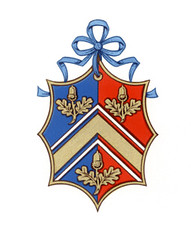Miss Middleton's Coat of Arms derives from one which is being granted to her father, Mr. Michael Middleton.
Miss Catherine Middleton has a new Coat of Arms in advance of her wedding to Prince William. Miss Middleton’s Coat of Arms derives from one which is being granted to her father, Mr. Michael Middleton. The design of the Arms was agreed and approved by Mr. Thomas Woodcock (Garter King of Arms and Senior Herald in England), who is based at the College of Arms in London.
The Middleton Family worked closely with the College of Arms throughout the design process to create a Coat of Arms that was personal to them and visually identified them as a family.
The three acorns represent Mr. and Mrs. Middleton’s three children (Catherine, Philippa and James). Acorns were chosen because the area in which the children were brought up – West Berkshire, England – is surrounded by oak trees. Additionally, oak is a long-established symbol of both ‘England’ and ‘Strength.’
The gold chevron, which sits at the centre of the design, represents Mrs. Middleton, whose maiden name is Goldsmith. The two thinner chevrons, which sit either side of the gold chevron, allude to hills and mountains and represent outdoor pursuits that the family enjoy together. The colours blue and red were chosen as they are the principle colours from the flag of the United Kingdom.
Miss Middleton’s Coat of Arms has been presented in the form of a ‘lozenge’ and is shown suspended from a ribbon, which indicates that she is an unmarried daughter.
Mr. Thomas Woodcock, Garter King of Arms said:
“Mr. and Mrs. Middleton and their children took enormous interest in this design and, while its purpose is to provide a traditional heraldic identity for Catherine, as she marries into the Royal Family, the intent was to represent the whole Middleton family together, their home and aspects of what they enjoy.
“Every Coat of Arms has been designed to identify a person, school or organisation, and to last forever: heraldry is Europe's oldest, most visual and strictly regulated form of identity and it surrounds us in Britain, giving clues to our history and surroundings. After her marriage, Catherine Middleton will place her father’s Arms beside those of her husband in what is known as an impaled Coat of Arms. This will require a Royal Warrant from The Queen."
The Grant of Arms has been made to Mr. Michael Middleton and his descendants in accordance with the laws of Arms, so all of his three children, including Catherine, are entitled to the Arms. Mr. James Middleton (Catherine’s brother) will pass the right on to his descendants.
Notes to editors:
An image of Catherine Middleton’s Coat of Arms is available from the Press Association.
The technical heraldic description of the Middleton Coat of Arms, known as a ‘blazon’ is Per pale Azure and Gules a Chevron Or cotised Argent between three Acorns slipped and leaved Or. Per Pale means that the Shield is divided vertically with one half blue (Azure) and the other half red (Gules). A Chevron Or means the gold chevron across the centre of the Shield. There arecotises either side of the chevron which are white (Argent). Slipped means ‘with a stalk,’ so the final part of the blazon – and distinguishing feature of the Shield – means three acorns with gold stalks and leaves.
Coats of Arms are granted under the Sovereign’s authority. Since the fifteenth century, this has been delegated to three Kings of Arms in England. They now have jurisdiction over England, Wales and Northern Ireland. In Scotland, Coats of Arms are granted by Lord Lyon King of Arms.
Like all applicants, Mr. Middleton started the process by submitting his request to England’s Earl Marshal, The Duke of Norfolk, who issued a warrant to the Kings of Arms agreeing to the granting of new Arms. In this case it fell to Garter and Clarenceux Kings of Arms (two of the three Kings of Arms) to grant the Middleton Coat of Arms by Letters Patent, as the Middleton Family live south of the River Trent, the historic division between north and south in England.

No comments:
Post a Comment